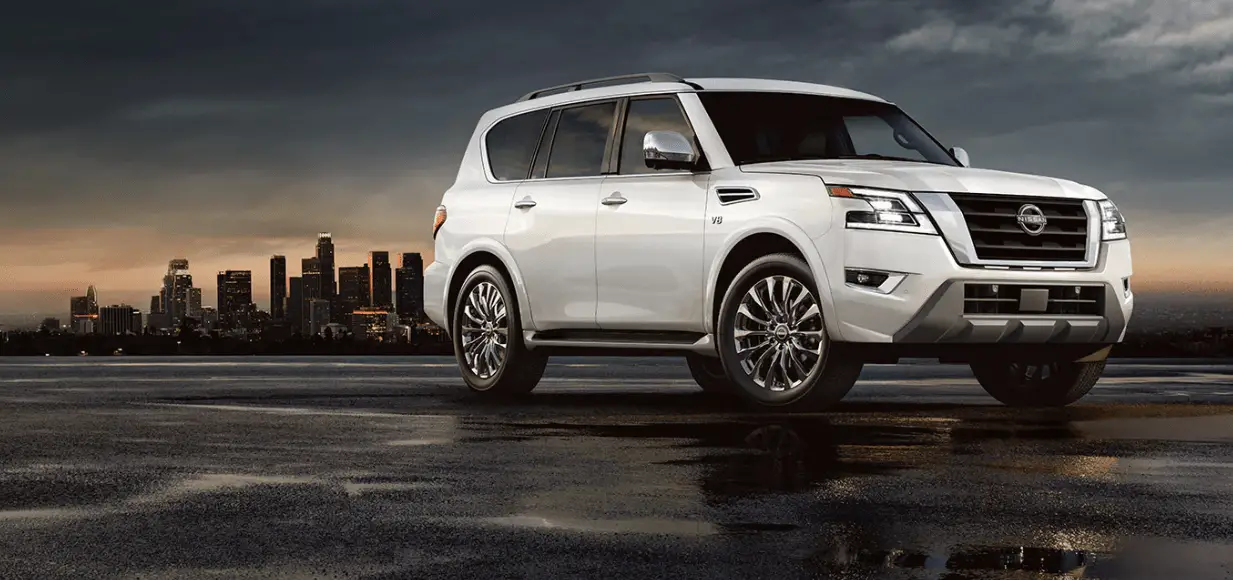Nissan ARMADA 2022 Blind Spot Warning (BSW) and Rear Cross Traffic Alert (RCTA)
Blind Spot Warning (BSW) and Rear Cross Traffic Alert (RCTA) are safety features in the Nissan Armada 2022 that help drivers detect potential hazards while driving. BSW alerts drivers to vehicles in their blind spots, while RCTA warns of approaching vehicles while reversing. These features work together to enhance safety and driving comfort. Radar sensors mounted on the Armada’s rear bumper detect vehicles in adjacent lanes for BSW. A warning light will illuminate in the corresponding side mirror if a vehicle is detected, alerting the driver to the potential danger. RCTA also uses the same sensors to detect vehicles approaching from either side while reversing. The system will issue an audible alert if a vehicle is detected, allowing the driver to respond accordingly. It’s important to note that while BSW and RCTA are useful features, they do not replace safe driving practices such as checking mirrors and blind spots. They are designed to supplement driver awareness and assist in avoiding accidents.
2023 Nissan Armada Specs, Price, Features and Mileage (Brochure)
BLIND SPOT WARNING (BSW)
WARNING
Failure to follow the warnings and instructions for proper use of the BSW system could result in serious injury or death.
- The BSW system is not a replacement for proper driving procedures and is not designed to prevent contact with vehicles or objects. When changing lanes, al-ways use the side and rear mirrors and turn and look in the direction your vehicle will move to ensure it is safe to change lanes. Never rely solely on the BSW system.
The BSW system helps alert the driver of other vehicles in adjacent lanes when changing lanes.
The BSW system uses radar sensors installed near the rear bumper to detect other vehicles in an adjacent lane.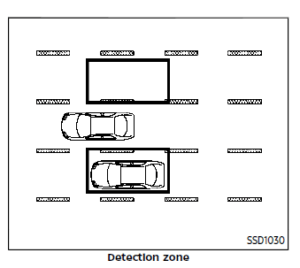
The radar sensors can detect vehicles on either side of your vehicle within the detection zone shown as illustrated. This detection zone starts from the outside mirror of your vehicle and extends approximately 10 ft (3.0 m) behind the rear bumper, and approximately 10 ft (3.0 m) sideways. When the turn signal is activated, the detection zone may extend more than approximately 10 ft (3.0 m).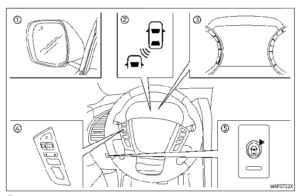
- Side indicator light
- BSW system warning light (on the vehicle information display)
- Vehicle information display
- Steering-wheel-mounted controls (left side)
- Warning systems switch
BSW SYSTEM OPERATION
The BSW system operates above approximately 20 MPH (32 km/h). If the radar sensors detect a vehicle in the detection zone, the side indicator light illuminates.
If the turn signal is then activated, the system chimes (twice), and the side indicator light flashes. The side indicator light continues to flash until the detected vehicle leaves the detection zone.
The side indicator light illuminates for a few seconds when the ignition switch is placed in the ON position.
The brightness of the side indicator light is adjusted automatically depending on the brightness of the ambient light.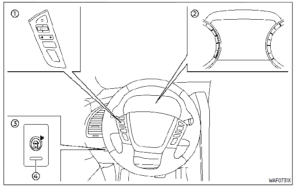
- Steering-wheel-mounted controls (left side)
- Vehicle information display
- Warning systems switch
- Warning systems ON indicator light
HOW TO ENABLE/DISABLE THE BSW SYSTEM
Perform the following steps to enable or disable the BSW system.
- Push the button until “Settings” appears in the vehicle information display and then push the OK. Use the button to select “Driver Assistance”. Then push the OK.
- Select “Blind Spot” and push the OK.
- Select “Warning (BSW)” and push the OK.
The warning systems switch is used to turn on and off the BSW system when it is activated on the vehicle information display. When the warning systems switch is turned off, the warning systems ON indicator light on the switch is off. The warning systems switch will turn on and off the LDW and BSW systems at the same time.
NOTE:
The system will retain current settings in the vehicle information display even if the engine is restarted.
BSW SYSTEM LIMITATIONS
WARNING
Listed below are the system limitations for the BSW system. Failure to operate the vehicle in accordance with these system limitations could result in serious injury or death.
- The BSW system cannot detect all vehicles under all conditions.
- The radar sensors may not be able to detect and activate BSW when certain objects are present such as:
- Pedestrians, bicycles, animals.
- Vehicles such as motorcycles, low-height vehicles, or high-ground clearance vehicles.
- Oncoming vehicles.
- Vehicles remaining in the detection zone when you accelerate from a stop.
- A vehicle merging into an adjacent lane at a speed approximately the same as your vehicle.
- A vehicle approached rapidly from behind.
- A vehicle that your vehicle overtakes rapidly.
- A vehicle passes through the detection zone quickly.
- When overtaking several vehicles in a row, the vehicles after the first vehicle may not be detected if they are travelling close together.
- The radar sensor’s detection zone is designed based on standard lane width. When driving in a wider lane, the radar sensors may not detect vehicles in an adjacent lane. When driving in a narrow lane, the radar sensors may detect vehicles driving two lanes away.
- The radar sensors are designed to ignore most stationary objects, however, objects such as guard rails, walls, foliage, and parked vehicles may occasionally be detected. This is a normal operating condition.
- The following conditions may reduce the ability of the radar to detect other vehicles:
- Severe weather
- Road spray
- Ice/frost/dirt build-up on the vehicle
- Do not attach stickers (including transparent material), install accessories or apply additional paint near the radar sensors. These conditions may reduce the ability of the radar to detect other vehicles.
- When towing a trailer or other vehicle, turn the BSW system off to prevent the occurrence of an unexpected accident resulting from sudden system operation.
- Excessive noise (for example, audio system volume, open vehicle window) will interfere with the chime sound, and it may not be heard.
BSW DRIVING SITUATIONS
- Indicator on
- Indicator off
- Indicator flashing
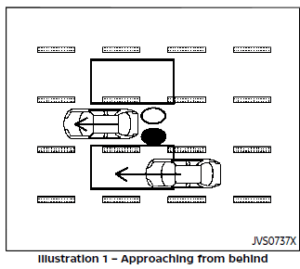 Another vehicle approaching from behind
Another vehicle approaching from behind
Illustration 1: The side indicator light illuminates if a vehicle enters the detection zone from behind in an adjacent lane.
Illustration 2 – Approaching from behind
Illustration 2: If the driver activates the turn signal while another vehicle is in the detection zone, then the system chimes (twice), and the side indicator light flashes.
NOTE:
- The radar sensors may not detect vehicles that are approaching rapidly from behind.
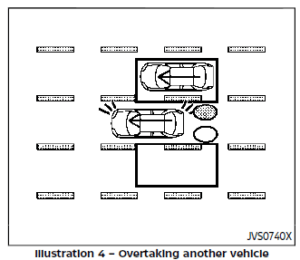 Overtaking another vehicle
Overtaking another vehicle
Illustration 3: The side indicator light illuminates if you overtake a vehicle and that vehicle stays in the detection zone for approximately 3 seconds.
The radar sensors may not detect slower-moving vehicles if they are passed quickly.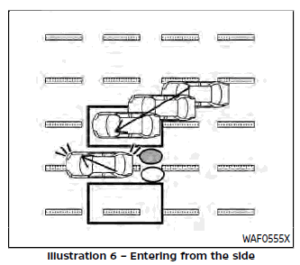
Illustration 4: If the driver activates the turn signal while another vehicle is in the detection zone, then the system chimes (twice) and the side indicator light flashes.
NOTE:
- When overtaking several vehicles in a row, the vehicles after the first vehicle may not be detected if they are traveling close together.
- The radar sensors may not detect slower-moving vehicles if they are passed quickly.
- If the driver activates the turn signal before a vehicle enters the detection zone, the side indicator light will flash but no chime will sound when the other vehicle is detected.
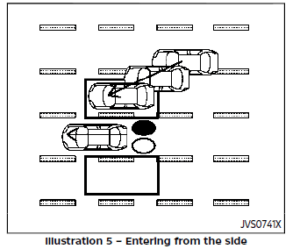 Entering from the side
Entering from the side
Illustration 5: The side indicator light illuminates if a vehicle enters the detection zone from either side. Illustration 6: If the driver activates the turn signal while another vehicle is in the detection zone, then the system chimes (twice) and the side indicator light flashes.
Illustration 6: If the driver activates the turn signal while another vehicle is in the detection zone, then the system chimes (twice) and the side indicator light flashes.
NOTE:
- The radar sensors may not detect a vehicle that is traveling at about the same speed as your vehicle when it enters the detection zone.
SYSTEM TEMPORARILY UNAVAILABLE
When radar blockage is detected, the BSW system will be turned off automatically, a chime will sound and the “Unavailable Side Radar Obstruction” warning message will appear in the vehicle information display. The system is not available until the conditions no longer exist. The radar sensors may be blocked by temporary ambient conditions such as splashing water, mist or fog. The blocked condition may also be caused by objects such as ice, frost or dirt obstructing the radar sensors.
NOTE:
If the BSW system stops working, the Intelligent Blind Spot Intervention (I-BSI) and the Rear Cross Traffic Alert (RCTA) systems will also stop working.
Action to take:
When the above conditions no longer exist, the system will resume automatically.
SYSTEM MALFUNCTION
When the BSW system malfunctions, it will be turned off automatically, the BSW indicator illuminates and the “Malfunction” warning message will appear in the vehicle information display.
NOTE:
If the BSW system stops working, the Intelligent Blind Spot Intervention (I-BSI) (if so equipped) and Rear Cross Traffic Alert (RCTA) systems will also stop working.
Action to take:
Stop the vehicle in a safe location, turn the engine off and restart the engine. If the message continues to appear, have the BSW system checked. It is recommended that you visit a NISSAN dealer for this service.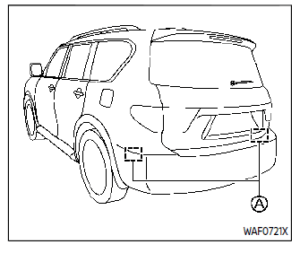
SYSTEM MAINTENANCE
The two radar sensors for the BSW system are located near the rear bumper. Always keep the area near the radar sensors clean. The radar sensors may be blocked by temporary ambient conditions such as splashing water, mist or fog. The blocked condition may also be caused by objects such as ice, frost or dirt obstructing the radar sensors. Check for and remove objects obstructing the area around the radar sensors. Do not attach stickers (including transparent material), install accessories or apply additional paint near the radar sensors. Do not strike or damage the area around the radar sensors. See a NISSAN dealer or other authorized repair shop if the area around the radar sensors is damaged due to a collision.
Radiofrequency statement
For the USA:
FCC ID: OAYSRR3B
This device complies with Part 15 of the FCC Rules. Operation is subject to the following two conditions:
- this device may not cause harmful interference, and
- this device must accept any interference received, including interference that may cause undesired operation.
CAUTION TO USERS
Changes or modifications not expressly approved by the party responsible for compliance could void the user’s authority to operate the equipment.
For Canada:
This device complies with Industry Cana-da license-exempt RSS standard(s). Operation is subject to the following two conditions: (1) this device may not cause interference, and (2) this device must accept any interference, including interference that may cause undesired operation of the device.
Frequency bands: 24.05 – 24.25 GHz
The field strength of SRR3-B is below 250 millivolts/m measured at 3 meters with an average detector. This device contains license-exempt transmitter(s)/receiver(s) that comply with Innovation, Science and Economic Development Canada’s license-exempt RSS(s). Operation is subject to the following two conditions:
- This device may not cause interference.
- This device must accept any interference, including interference that may cause undesired operation of the device.
Radiofrequency radiation exposure information:
This equipment complies with radiation exposure limits set forth for an uncontrolled environment. This equipment should be installed and operated with a minimum distance of 20 cm between the radiator and your body.
2023 Nissan Armada Specs, Price, Features and Mileage (Brochure)
INTELLIGENT BLIND SPOT INTERVENTION (I-BSI)
WARNING
Failure to follow the warnings and instructions for proper use of the I-BSI system could result in serious injury or death.
- The I-BSI system is not a replacement for proper driving procedures and is not designed to prevent contact with vehicles or objects. When changing lanes, always use the side and rear mirrors and turn and look in the direction your vehicle will move to ensure it is safe to change lanes. Never rely solely on the I-BSI system.
- There is a limitation to the detection capability of the radar. Not every moving object or vehicle will be detected. Using the I-BSI system under some road, ground, lane marker, traffic, or weather conditions could lead to improper system operation. Always rely on your own operation to avoid accidents.
The I-BSI system helps alert the driver of other vehicles in adjacent lanes when changing lanes, and helps assist the 5-46 Starting and driving driver to return the vehicle to the center of the traveling lane.
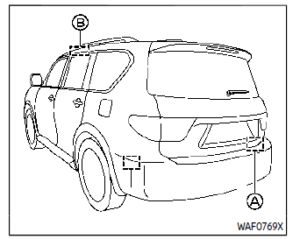
The I-BSI system uses radar sensors installed near the rear bumper to detect other vehicles in an adjacent lane. In addition to the radar sensors, the I-BSI system uses a camera installed behind the windshield to monitor the lane markers of your travelling lane.
 The radar sensors can detect vehicles on either side of your vehicle within the detection zone shown as illustrated.
The radar sensors can detect vehicles on either side of your vehicle within the detection zone shown as illustrated.
This detection zone starts from the out-side mirror of your vehicle and extends approximately 10 ft (3.0 m) behind the rear bumper, and approximately 10 ft (3.0 m) sideways.
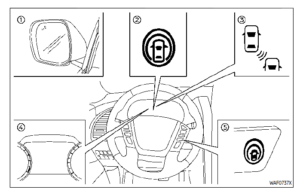
- Side indicator light
- I-BSI ON indicator light (on the vehicle information display)
- I-BSI indicator (on the vehicle information display)
- Vehicle information display
- Dynamic driver assistance switch
I-BSI SYSTEM OPERATION
The I-BSI system operates above approximately 37 MPH (60 km/h). If the radar sensors detect a vehicle in the detection zone, the side indicator light illuminates. If the turn signal is then activated, the system chimes (twice) and the side indicator light flashes. The side indicator light continues to flash until the detected vehicle leaves the detection zone.
If the I-BSI system is ON and your vehicle approaches a lane marker while another vehicle is in the detection zone, the system chimes (three times) and the side indicator light flashes. Then the I-BSI system slightly applies the brakes to help return the vehicle back to the center of the driving lane. The I-BSI system operates regardless of turn signal usage.
NOTE:
- I-BSI warning and system application will only be activated if the side indicator light is already illuminated when your vehicle approaches a lane marker. If another vehicle comes into the detection zone after your vehicle has crossed a lane marker, no I-BSI warning or system application will be activated.
- The I-BSI system is typically activated earlier than the Intelligent Lane Intervention (I-LI) system when your vehicle is approaching a lane marker.
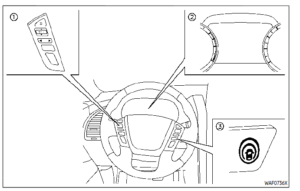
- Steering-wheel-mounted control (left side)
- Vehicle information display
- Dynamic driver assistance switch
HOW TO ENABLE/DISABLE THE I-BSI SYSTEM
- Push the button until “Settings” appears in the vehicle information display and then push the OK. Use the button to select “Driver Assistance.” Then push the OK.
- Select “Blind Spot” and push the OK.
- Select “Intervention (BSI)” and push the OK.
- Push the Dynamic driver assistance switch to turn the system on or off.
The dynamic driver assistance switch is used for the I-LI and I-BSI systems. When the dynamic driver assistance switch is pushed, the I-LI system will also turn on or off simultaneously. The I-BSI system can be individually set to on or off on the vehicle information display. If the system is set to off, the system will not turn on even if the dynamic driver assistance switch is pushed to on.
I-BSI SYSTEM LIMITATIONS
WARNING
Listed below are the system limitations for the I-BSI system. Failure to operate the vehicle in accordance with these system limitations could result in serious injury or death.
- The I-BSI system cannot detect all vehicles under all conditions.
- The radar sensors may not be able to detect and activate I-BSI when certain objects are present such as:
- Pedestrians, bicycles, animals.
- Vehicles such as motorcycles, low-height vehicles, or high-ground clearance vehicles.
- Vehicles remaining in the detection zone when you accelerate from a stop.
- Oncoming vehicles.
- A vehicle merging into an adjacent lane at a speed approximately the same as your vehicle.
- A vehicle approached rapidly from behind.
- A vehicle that your vehicle overtakes rapidly.
- A vehicle passes through the detection zone quickly.
- The radar sensor’s detection zone is designed based on standard lane width. When driving in a wider lane, the radar sensors may not detect vehicles in an adjacent lane. When driving in a narrow lane, the radar sensors may detect vehicles driving two lanes away.
- The radar sensors are designed to ignore most stationary objects, however, objects such as guard rails, walls, foliage, and parked vehicles may occasionally be detected. This is a normal operating condition.
- The following conditions may reduce the ability of the radar to detect other vehicles:
- Severe weather
- Road spray
- Ice/frost/dirt build-up on the vehicle
- Do not attach stickers (including transparent material), install accessories or apply additional paint near the radar sensors. These conditions may reduce the ability of the radar to detect other vehicles.
- The camera may not detect lane markers in the following situations and the I-BSI system may not operate properly.
- On roads where there are multiple parallel lane markers; lane markers that are faded or not painted clearly; yellow painted lane markers; nonstandard lane markers; lane markers covered with water, dirt, snow, etc.
- On roads where discontinued lane markers are still detectable.
- On roads where there are sharp curves.
- On roads where there are sharply contrasting objects, such as shadows, snow, water, wheel ruts, seams or lines remaining after road repairs.
- On roads where the travelling lane merges or separates.
- When the vehicle’s travelling direction does not align with the lane markers.
- When travelling close to the vehicle in front of you, which obstructs the lane camera unit detection range.
- When rain, snow or dirt adheres to the windshield in front of a lane camera unit.
- When the headlights are not bright due to dirt on the lens or if aiming is not adjusted properly.
When strong light enters a lane camera unit. (For example light directly shines on the front of the vehicle at sunrise or sunset.) - When a sudden change in brightness occurs. (For example: when the vehicle enters or exits a tunnel or under a bridge.)
- Do not use the I-BSI system under the following conditions because the system may not function properly.
- During bad weather. (For example rain, fog, snow, etc.)
- When driving on slippery roads, such as on ice or snow, etc.
- When driving on winding or uneven roads.
- When there is a lane closure due to road repairs.
- When driving in a makeshift or temporary lane.
- When driving on roads where the lane width is too narrow.
- When driving with a tire that is not within normal tire conditions (for example, tire wear, low tire pressure, installation of spare tire, tire chains, non standard wheels).
- When the vehicle is equipped with non-original steering parts or suspension parts.
- When towing a trailer or other vehicle.
- Excessive noise (for example, audio system volume, open vehicle window) will interfere with the chime sound, and it may not be heard.
I-BSI DRIVING SITUATIONS
- Indicator on
- Indicator off
- Indicator flashing
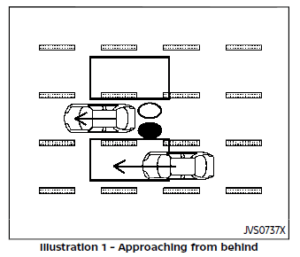 Another vehicle approached from behind
Another vehicle approached from behind
Illustration 1: The side indicator light illuminates if a vehicle enters the detection zone from behind in an adjacent lane.
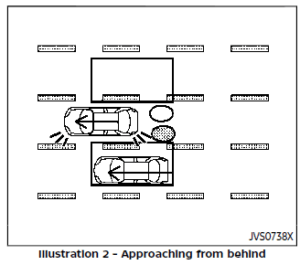 Illustration 2: If the driver activates the turn signal then the system chimes (twice) and the side indicator light flashes.
Illustration 2: If the driver activates the turn signal then the system chimes (twice) and the side indicator light flashes.
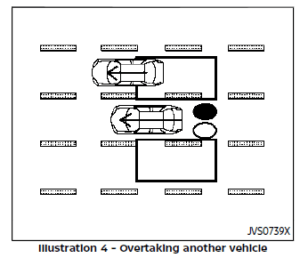 Illustration 3: If the I-BSI system is on and your vehicle approaches a lane marker while another vehicle is in the detection zone, the system chimes (three times) and the side indicator light flashes. Then the I-BSI system slightly applies the brakes to help return the vehicle back to the center of the driving lane.
Illustration 3: If the I-BSI system is on and your vehicle approaches a lane marker while another vehicle is in the detection zone, the system chimes (three times) and the side indicator light flashes. Then the I-BSI system slightly applies the brakes to help return the vehicle back to the center of the driving lane.
NOTE:
- The radar sensors may not detect vehicles which are approaching rapidly from behind.
 Overtaking another vehicle
Overtaking another vehicle
Illustration 4: The side indicator light illuminates if you overtake a vehicle and that vehicle stays in the detection zone for approximately 3 seconds.
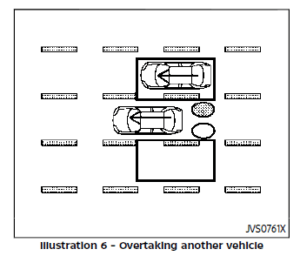 Illustration 5: If the driver activates the turn signal while another vehicle is in the detection zone, then the system chimes (twice) and the side indicator light flashes.
Illustration 5: If the driver activates the turn signal while another vehicle is in the detection zone, then the system chimes (twice) and the side indicator light flashes.
 Illustration 6: If the I-BSI system is on and your vehicle approaches a lane marker while another vehicle is in the detection zone, the system chimes (three times) and the side indicator light flashes. The I-BSI system activates to help return the vehicle back to the center of the driving lane.
Illustration 6: If the I-BSI system is on and your vehicle approaches a lane marker while another vehicle is in the detection zone, the system chimes (three times) and the side indicator light flashes. The I-BSI system activates to help return the vehicle back to the center of the driving lane.
NOTE:
- When overtaking several vehicles in a row, the vehicles after the first vehicle may not be detected if they are traveling close together.
- The radar sensors may not detect slower-moving vehicles if they are passed quickly.
 Entering from the side
Entering from the side
Illustration 7: The side indicator light illuminates if a vehicle enters the detec-tion zone from either side.
NOTE:
The radar sensors may not detect a vehicle that is traveling at about the same speed as your vehicle when it enters the detection zone.
 Illustration 8: If the driver activates the turn signal while another vehicle is in the detection zone, then the side indicator light flashes and a chime will sound twice.
Illustration 8: If the driver activates the turn signal while another vehicle is in the detection zone, then the side indicator light flashes and a chime will sound twice.
NOTE:
If the driver activates the turn signal before a vehicle enters the detection zone, the side indicator light will flash but no chime will sound when another vehicle is detected.
Illustration 9: If the I-BSI system is on and your vehicle approaches the lane marker while another vehicle is in the detection zone, the system chimes (three times) and the side indicator light flashes. The I-BSI system activates to help return the vehicle back to the center of the driving lane.
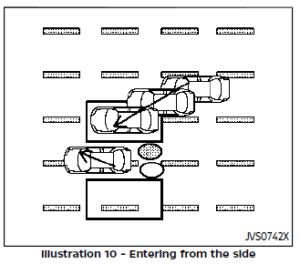 Illustration 10: The I-BSI system will not operate if your vehicle is on a lane marker when another vehicle enters the detection zone. In this case only the BSW system operates.
Illustration 10: The I-BSI system will not operate if your vehicle is on a lane marker when another vehicle enters the detection zone. In this case only the BSW system operates.
NOTE:
- The radar sensors may not detect a vehicle that is travelling at about the same speed as your vehicle when it enters the detection zone.
- I-BSI will not operate or will stop operating and only a warning chime will sound under the following conditions.
- When the brake pedal is depressed.
- When the vehicle is accelerated during I-BSI system operation
- When steering quickly
- When the ICC, I-FCW or AEB warnings sound.
- When the hazard warning flashers are operated.
- When driving on a curve at a high speed.
- When the BSW system is turned
SYSTEM TEMPORARILY UNAVAILABLE
When any of the following messages appear on the vehicle information display, a chime will sound and the I-BSI system will be turned off automatically.
- “Not Available: Poor Road Conditions”: When the VDC system (except traction control system function) or ABS operates.
- “Currently unavailable/Currently not available”:
- When the VDC system is turned off.
- When the SNOW mode is selected
- When the 4WD shift switch is in the
4H or 4L position. (4WD models)
- “Not Available: High Camera Temp”: If the vehicle is parked in direct sunlight under high-temperature conditions (over approximately 104°F (40°C)).
- “Unavailable Side Radar Obstruction”:
When side radar blockage is detected. Turn off the I-BSI system and turn it on again when the above conditions no longer exist.
SYSTEM MALFUNCTION
When the I-BSI system malfunctions, it will be turned off automatically, the I-BSI indicator illuminates and a chime will sound, and the “Malfunction” warning message will appear in the vehicle information display.
Action to take:
Stop the vehicle in a safe location and push the park button to engage the P (Park) position. Turn the engine off and restart the engine. If the warning message continues to appear, It is recommended you visit a NISSAN dealer for this service.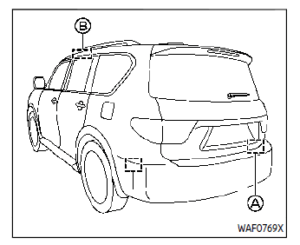
SYSTEM MAINTENANCE
The two radar sensors for the I-BSI system are located near the rear bumper. Always keep the area near the radar sensors clean. The radar sensors may be blocked by temporary ambient conditions such as splashing water, mist or fog. The blocked condition may also be caused by objects such as ice, frost or dirt obstructing the radar sensors. Check for and remove objects obstructing the area around the radar sensors.
Do not attach stickers (including transparent material), install accessories or apply additional paint near the radar sensors.
Do not strike or damage the area around the radar sensors.
It is recommended you visit a NISSAN dealer if the area around the radar sensors is damaged due to a collision.
The lane camera unit for I-BSI system is located above the inside mirror. To keep the proper operation of I-BSI and prevent a system malfunction, be sure to observe the following:
- Always keep the windshield clean.
- Do not attach a sticker (including transparent material) or install an accessory near the camera unit.
- Do not place reflective materials, such as white paper or a mirror, on the instrument panel. The reflection of sunlight may adversely affect the camera unit’s capability of detecting the lane markers.
- Do not strike or damage the areas around the camera unit. Do not touch the camera lens or remove the screw located on the camera unit. It is recommended you contact a NISSAN dealer if the camera unit is damaged due to an accident.
Radiofrequency statement
For the USA:
FCC ID: OAYSRR3B
This device complies with Part 15 of the FCC Rules. Operation is subject to the following two conditions:
- this device may not cause harmful interference, and
- this device must accept any interference received, including interference that may cause undesired operation.
CAUTION TO USERS
Changes or modifications not expressly approved by the party responsible for compliance could void the user’s authority to operate the equipment.
For Canada:
This device complies with Industry Cana-da license-exempt RSS standard(s). Operation is subject to the following two conditions: (1) this device may not cause interference, and (2) this device must accept any interference, including interference that may cause undesired operation of the device.
Frequency bands: 24.05 – 24.25 Ghz
The field strength of SRR3-B is below 250 millivolts/m measured at 3 metros with an average detector.
This device contains license-exempt transmitter(s)/receiver(s) that comply with Innovation, Science and Economic Development Canada’s licence-exempt RSS(s). Operation is subject to the following two conditions:
- This device may not cause interference.
- This device must accept any interference, including interference that may cause undesired operation of the device.
Radiofrequency radiation exposure information:
This equipment complies with radiation exposure limits set forth for an uncontrolled environment. This equipment should be installed and operated with a minimum distance of 20 cm between the radiator and your body.
REAR CROSS TRAFFIC ALERT (RCTA) (if so equipped)
WARNING
Failure to follow the warnings and instructions for proper use of the RCTA system could result in serious injury or death.
- The RCTA system is not a replacement for proper driving procedures and is not designed to prevent contact with vehicles or objects. When backing out of a parking space, always use the side and rear mirrors and turn and look in the direction your vehicle will move. Never rely solely on the RCTA system.
The RCTA system will assist you when backing out from a parking space. When the vehicle is in reverse, the system is designed to detect other vehicles approaching from the right or left of the vehicle. If the system detects cross traffic, it will alert you.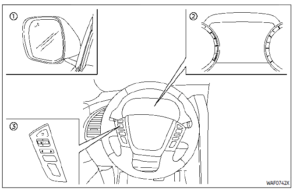
- Side indicator light
- Vehicle information display
- Steering-wheel-mounted controls (left side)
RCTA SYSTEM OPERATION
The RCTA system can help alert the driver of an approaching vehicle when the driver is backing out of a parking space.
When the shift position is in R (Reverse) and the vehicle speed is less than approximately 5 MPH (8 km/h), the RCTA system is operational.
If the radar detects an approaching vehicle from either side, the system chimes (once) and the side indicator light flashes on the side the vehicle is approaching from.

The RCTA system uses radar sensors installed on both sides near the rear bumper to detect an approaching vehicle.
The radar sensors can detect an approaching vehicle from up to approximately 66 ft (20 m) away.
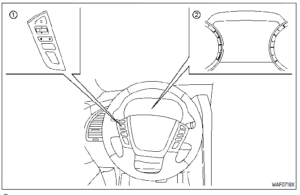
- Steering-wheel-mounted controls (left side)
- Vehicle information display
HOW TO ENABLE/DISABLE THE RCTA SYSTEM
Perform the following steps to enable or disable the RCTA system.
- Push the button until “Settings” appears in the vehicle information display and then push the OK. Use the button to select “Driver Assistance”. Then push the OK.
- Use the button to select “Cross Traffic Alert” then press the OK.
- use the OK to enable or disable the system.
NOTE:
The system setting will be retained even if the engine is restarted.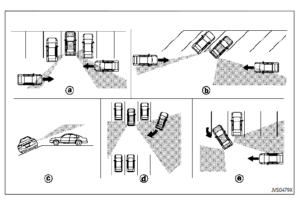
RCTA SYSTEM LIMITATIONS
WARNING
Listed below are the system limitations for the RCTA system. Failure to operate the vehicle in accordance with these system limitations could result in serious injury or death.
- Always check your surroundings and turn to check what is behind you before backing up. The radar sensors detect approaching (moving) vehicles. The radar sensors cannot detect every object such as:
- Pedestrians, bicycles, motorcycles, animals or child-operated toy vehicles
- A vehicle that is passing at speeds greater than approximately 19 MPH (30 km/h)
- A vehicle that is passing at speeds lower than approximately 5 MPH (8 km/h)
- The radar sensors may not detect approaching vehicles in certain situations:
- Illustration: When a vehicle parked next to you obstructs the beam of the radar sensor.
- Illustration: When the vehicle is parked in an angled parking space.
- Illustration: When the vehicle is parked on the inclined ground.
- Illustration: When an approaching vehicle turns into your vehicle’s parking lot aisle.
- Illustration: When the angle formed by your vehicle and the approaching vehicle is small
- The following conditions may reduce the ability of the radar to detect other vehicles:
- Severe weather
- Road spray
- Ice/frost/dirt build-up on the vehicle
- Do not attach stickers (including transparent material), install accessories or apply additional paint near the radar sensors. These conditions may reduce the ability of the radar to detect other vehicles
- When towing a trailer or other vehicle, turn the RCTA system off to prevent the occurrence of an unexpected accident resulting from a sudden system operation.
- Excessive noise (e.g. audio system volume, open vehicle window) will interfere with the chime sound, and it may not be heard.
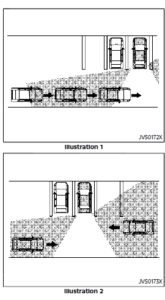
NOTE:
In the case of several vehicles approaching in a row (Illustration 1) or in the opposite direction (Illustration 2), a chime may not be sounded by the RCTA system after the first vehicle passes the sensors.
SYSTEM TEMPORARILY UNAVAILABLE
When radar blockage is detected, the system will be deactivated automatically. The “Unavailable Side Radar Obstruction” warning message will appear in the vehicle information display. The systems are not available until the conditions no longer exist. The radar sensors may be blocked by temporary ambient conditions such as splashing water, mist or fog.
The blocked condition may also be caused by objects such as ice, frost or dirt obstructing the radar sensors.
NOTE:
If the BSW system stops working, the RCTA and Intelligent Blind Spot Intervention (I-BSI) systems will also stop working.
Action to take:
When the above conditions no longer exist, the system will resume automatically.
SYSTEM MALFUNCTION
When the RCTA system malfunctions, it will turn off automatically. The “Malfunction” warning message will appear in the vehicle information display.
NOTE:
If the BSW system stops working, the RCTA and I-BSI systems will also stop working.
Action to take:
Stop the vehicle in a safe location, turn the engine off and restart the engine. If the message continues to appear, have the system checked. It is recommended that you visit a NISSAN dealer for this service.
SYSTEM MAINTENANCE
The two radar sensors for the RCTA system are located near the rear bumper. Always keep the area near the radar sensors clean. The radar sensors may be blocked by temporary ambient conditions such as splashing water, mist or fog. The blocked condition may also be caused by objects such as ice, frost or dirt obstructing the radar sensors. Check for and remove objects obstructing the area around the radar sensors. Do not attach stickers (including trans-parent material), install accessories or apply additional paint near the radar sensors. Do not strike or damage the area around the radar sensors. It is recommended that you visit a NISSAN dealer if the area around the radar sensors is damaged due to a collision.
Radiofrequency statement
For USA:
FCC ID: OAYSRR3B
This device complies with Part 15 of the FCC Rules. Operation is subject to the following two conditions:
- this device may not cause harmful interference, and
- this device must accept any interference received, including interference that may cause undesired operation.
CAUTION TO USERS
Changes or modifications not expressly approved by the party responsible for compliance could void the user’s authority to operate the equipment.
For Canada:
This device complies with Industry Canada licence-exempt RSS standard(s). Operation is subject to the following two conditions: (1) this device may not cause interference, and (2) this device must accept any interference, including interference that may cause undesired operation of the device.
Frequency bands: 24.05 – 24.25 GHz
The field strength of SRR3-B is below 250 millivolts/m measured at 3 meters with an average detector.
This device contains license-exempt transmitter(s)/receiver(s) that comply with Innovation, Science and Economic Development Canada’s license-exempt RSS(s).
Operation is subject to the following two conditions:
- This device may not cause interference.
- This device must accept any interference, including interference that may cause undesired operation of the device.
Radiofrequency radiation exposure information:
This equipment complies with radiation exposure limits set forth for an uncontrolled environment. This equipment should be installed and operated with a minimum distance of 20 cm between the radiator and your body.
FAQ
What is Blind Spot Warning (BSW)?
Blind Spot Warning (BSW) is a safety feature in the Nissan Armada 2022 that uses radar sensors to detect vehicles in adjacent lanes. If a vehicle is detected, a warning light illuminates in the corresponding side mirror, alerting the driver to the potential hazard.
What is Rear Cross Traffic Alert (RCTA)?
Rear Cross Traffic Alert (RCTA) is another safety feature in the Nissan Armada 2022 that uses the same radar sensors to detect vehicles approaching from either side while reversing. The system will issue an audible alert if a vehicle is detected.
Can Blind Spot Warning (BSW) and Rear Cross Traffic Alert (RCTA) be turned off?
Yes, both features can be turned off using the vehicle’s settings menu.
How far away can Blind Spot Warning (BSW) detect vehicles?
BSW can detect vehicles up to 10 feet away from the rear of the vehicle.
Can Blind Spot Warning (BSW) detect motorcycles and bicycles?
Yes, BSW can detect motorcycles and bicycles in addition to other vehicles.
What is the purpose of Blind Spot Warning (BSW)?
The purpose of BSW is to help drivers detect vehicles in their blind spots and avoid potential collisions.
What is the purpose of Rear Cross Traffic Alert (RCTA)?
The purpose of RCTA is to help drivers detect vehicles approaching from either side while reversing and avoid potential collisions.
Can Blind Spot Warning (BSW) and Rear Cross Traffic Alert (RCTA) prevent accidents?
While BSW and RCTA can help drivers detect potential hazards, they are not designed to prevent accidents on their own. Drivers must still practice safe driving habits.
Can Blind Spot Warning (BSW) and Rear Cross Traffic Alert (RCTA) detect pedestrians?
No, BSW and RCTA are designed to detect vehicles only.
Can Blind Spot Warning (BSW) and Rear Cross Traffic Alert (RCTA) be installed on older Nissan Armada models?
It depends on the specific model and year. These features may not be available on older models.
Can Blind Spot Warning (BSW) and Rear Cross Traffic Alert (RCTA) be disabled if they become a distraction?
Yes, both features can be disabled if necessary.
What happens if Blind Spot Warning (BSW) or Rear Cross Traffic Alert (RCTA) malfunctions?
If either feature malfunctions, a warning message will appear on the dashboard display. The system may need to be serviced.
Are Blind Spot Warning (BSW) and Rear Cross Traffic Alert (RCTA) standard features in the Nissan Armada 2022?
Yes, both features are standard on all trim levels of the Nissan Armada 2022.
Can Blind Spot Warning (BSW) and Rear Cross Traffic Alert (RCTA) be added as options to lower trim levels?
It depends on the specific trim level and options package. Consult a Nissan dealer for more information.
Are Blind Spot Warning (BSW) and Rear Cross Traffic Alert (RCTA) available on other Nissan models?
Yes, both features are available on other Nissan models such as the Rogue, Murano, and Pathfinder.
Useful Link
View Full User Guide: Nissan ARMADA 2022 User Guide
Download Manuals: https://www.nissanusa.com/owners/ownership/manuals-guides.html
2023 Nissan Armada Specs, Price, Features and Mileage (Brochure)

